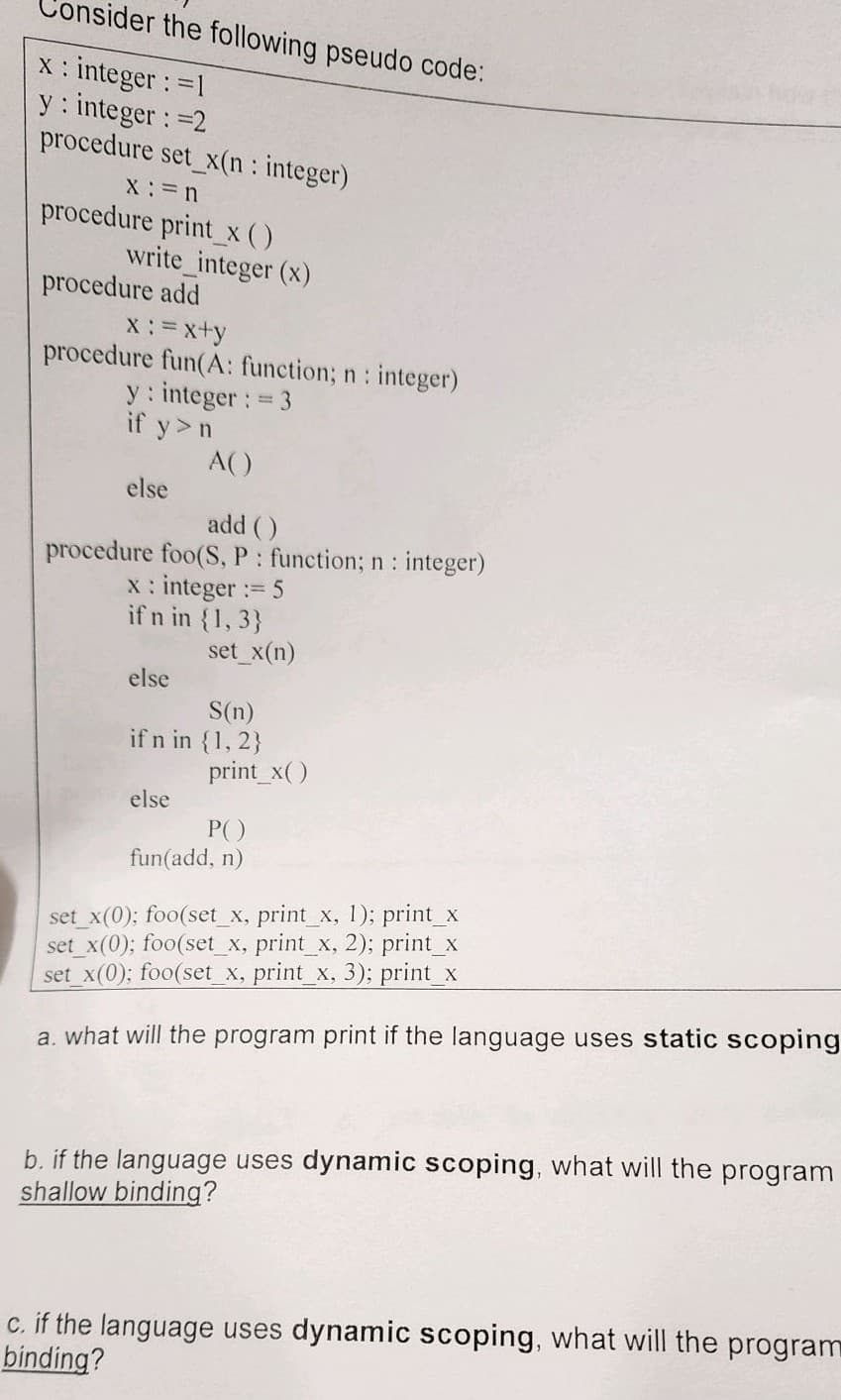der the following pseudo code: x : integer : =1 y: integer :=2 procedure set_x(n: integer) X: n procedure print_x () write_integer (x) procedure add x :=x+y procedure fun(A: function; n: integer) y: integer : = 3 if y>n A() add () procedure foo(S, P: function; n: integer) x : integer := 5 if n in {1, 3} else else set_x(n) S(n) if n in {1, 2} else print_x() P() fun(add, n) set_x(0); foo(set_x, print_x, 1); print_x set_x(0); foo(set_x, print_x, 2); print_x set_x(0); foo(set_x, print_x, 3); print_x a. what will the program print if the language uses static scoping b. if the language uses dynamic scoping, what will the program shallow binding?
der the following pseudo code: x : integer : =1 y: integer :=2 procedure set_x(n: integer) X: n procedure print_x () write_integer (x) procedure add x :=x+y procedure fun(A: function; n: integer) y: integer : = 3 if y>n A() add () procedure foo(S, P: function; n: integer) x : integer := 5 if n in {1, 3} else else set_x(n) S(n) if n in {1, 2} else print_x() P() fun(add, n) set_x(0); foo(set_x, print_x, 1); print_x set_x(0); foo(set_x, print_x, 2); print_x set_x(0); foo(set_x, print_x, 3); print_x a. what will the program print if the language uses static scoping b. if the language uses dynamic scoping, what will the program shallow binding?
C++ for Engineers and Scientists
4th Edition
ISBN:9781133187844
Author:Bronson, Gary J.
Publisher:Bronson, Gary J.
Chapter6: Modularity Using Functions
Section6.4: A Case Study: Rectangular To Polar Coordinate Conversion
Problem 9E: (Numerical) Write a program that tests the effectiveness of the rand() library function. Start by...
Related questions
Question
Can someone explain the output of this pseudocode code to me?
Also S(n) is set_x() and P() is print_x()
I will rate!

Transcribed Image Text:sider the following pseudo code:
x : integer : =1
y: integer : =2
procedure set_x(n: integer)
X:=n
procedure print_x ( )
write_integer (x)
procedure add
x :=x+y
procedure fun(A: function; n: integer)
y: integer : = 3
if y>n
else
add ()
procedure foo(S, P: function; n: integer)
x : integer := 5
if n in {1,3}
else
A()
else
set_x(n)
S(n)
if n in {1, 2}
print_x()
P()
fun(add, n)
set_x(0); foo(set_x, print_x, 1); print_x
set_x(0); foo(set_x, print_x, 2); print_x
set_x(0); foo(set_x, print_x, 3); print_x
a. what will the program print if the language uses static scoping
b. if the language uses dynamic scoping, what will the program
shallow binding?
c. if the language uses dynamic scoping, what will the program
binding?
Expert Solution
This question has been solved!
Explore an expertly crafted, step-by-step solution for a thorough understanding of key concepts.
This is a popular solution!
Trending now
This is a popular solution!
Step by step
Solved in 5 steps

Knowledge Booster
Learn more about
Need a deep-dive on the concept behind this application? Look no further. Learn more about this topic, computer-science and related others by exploring similar questions and additional content below.Recommended textbooks for you

C++ for Engineers and Scientists
Computer Science
ISBN:
9781133187844
Author:
Bronson, Gary J.
Publisher:
Course Technology Ptr

C++ for Engineers and Scientists
Computer Science
ISBN:
9781133187844
Author:
Bronson, Gary J.
Publisher:
Course Technology Ptr